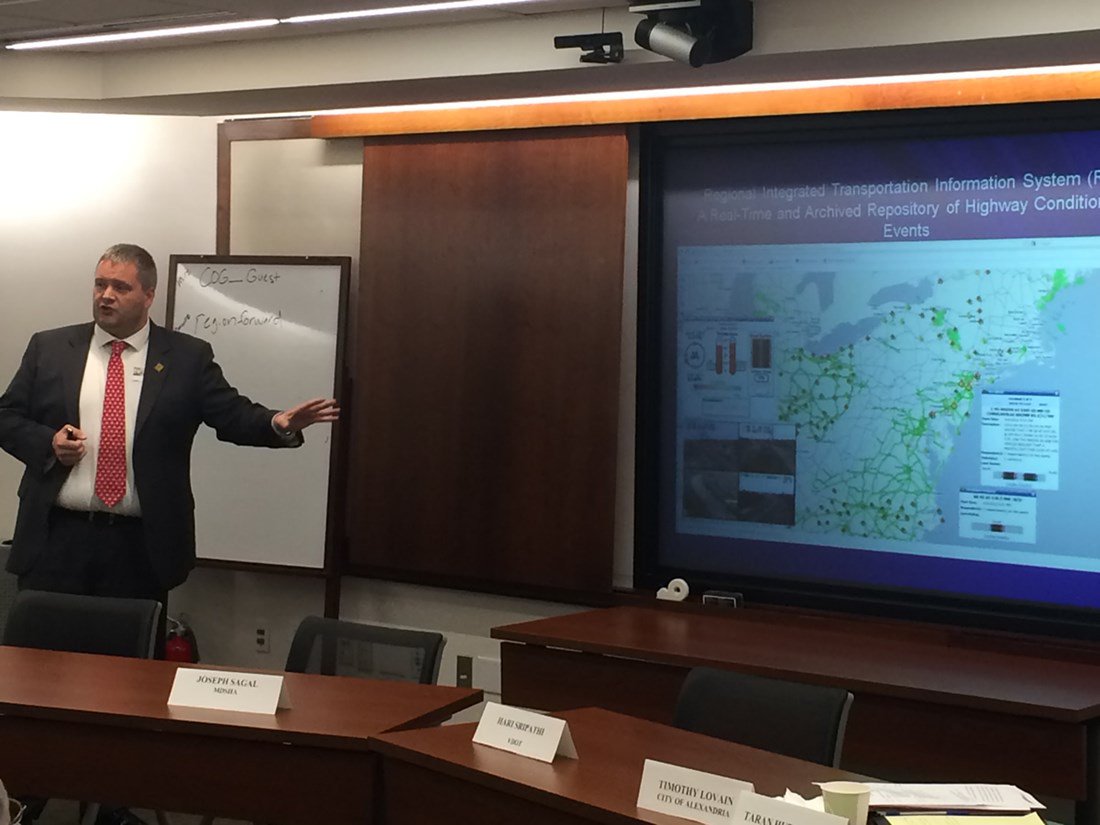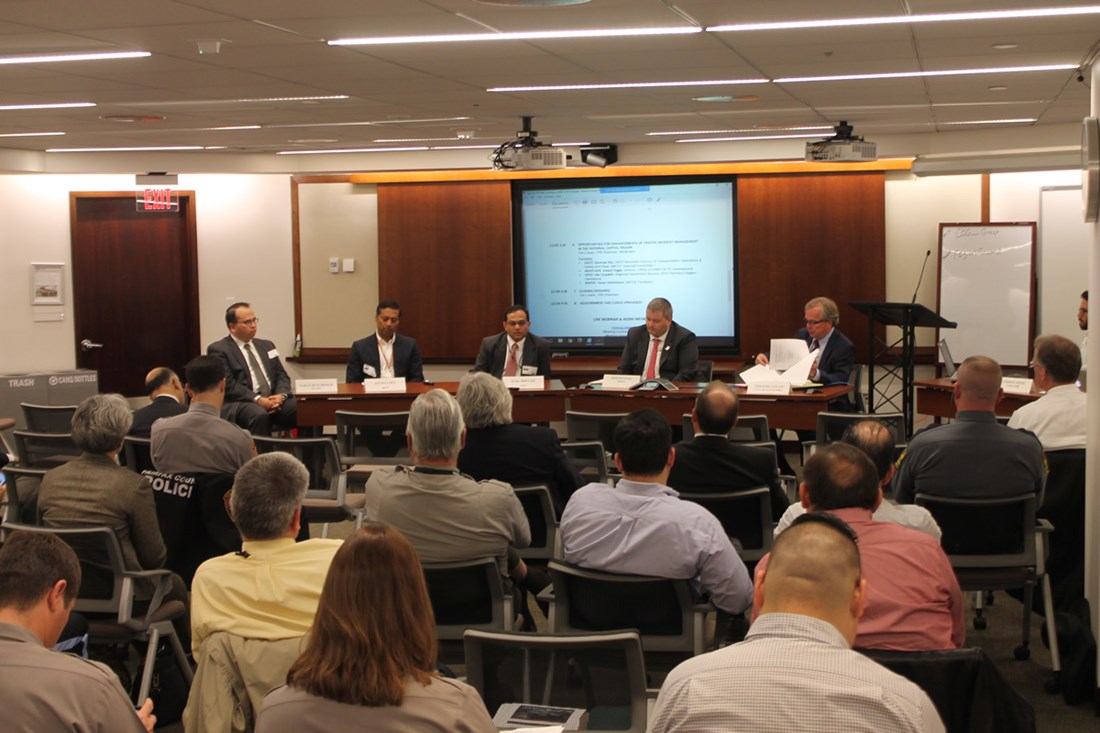At some point, most drivers have experienced a traffic back-up caused by a crash or some other incident. The faster that first responders can get to the scene and the sooner the incident is cleared, the sooner the rest of traffic can move along its way. At a recent half-day conference, TPB members and other regional officials gathered to learn more about ongoing traffic incident management efforts in the region and what leaders can do to champion further enhancements.
Traffic Incident Management—known in the business as “TIM”
An entire field of practice is devoted to responding to and clearing traffic incidents quickly and efficiently. This practice is known as Traffic Incident Management, or TIM, and it involves a wide range of emergency and transportation services personnel, including law enforcement, fire and rescue, emergency medical services, traffic, transportation, towing, and others. Orchestrating the response by so many different groups can require an extraordinary degree of real-time coordination, not only among these groups but across jurisdictional boundaries.
On November 2, the TPB hosted a half-day conference devoted to exploring ways the TPB and member agencies can champion and strengthen traffic incident management in the region. Representatives from the departments of transportation in Maryland (MDOT), Virginia (VDOT), and the District of Columbia (DDOT) came together with incident managers, highway patrol officers, and others to share strategies and to hear lessons from other metropolitan areas, including Las Vegas and Philadelphia. Traffic incident management is a particular interest of the TPB’s current chairman, Tim Lovain, who helped organize and emcee the conference. While the region’s existing TIM activities are quite strong compared to other metropolitan areas, agencies continue to look for ways to achieve further improvements.
Traffic operations and law enforcement have to work together
The major theme of the November 2 conference was the importance of working together and sharing information. Every presenter talked about the need for having their incident response centers work with traffic operations staff and police, fire, and other first responders.
Joseph Sagal, from the Maryland State Highway Administration, explained how the agency’s Coordinated Highways Action Response Team (CHART) works closely with the Maryland State Police, both by co-locating the traffic operations center at police barracks in College Park and by having state police staffing during peak rush hours and in emergency situations.

The Maryland State Highway Administration’s Joseph Sagal presents on the agency’s Coordinated Highways Action Response Team (CHART) traffic incident management program.
Ensuring coordination between traffic operations and first responders means all of them have to be trained to have the skills and understanding to work together and stay safe. VDOT’s Hari Sripathi explained how important it is to train first responders to keep themselves safe and be aware of traffic when they arrive at the scene of a crash or other incident. For the incident patrols and other operations, training on how the police radio channels work can be integral in understanding what is needed in each situation.
Cross-agency (and jurisdictional) cooperation is vital
Understanding what is happening moment-to-moment on the roads allows response teams to arrive and help faster. Data collection, cameras, and social media can all help dispatchers better understand what is needed and can help drivers know what to expect when approaching a back-up or incident. This can help shorten the overall duration of an event by shortening the detection, verification, response, and clearance stages. And it can help avoid “secondary crashes” caused by the back-ups resulting from an initial incident.
Regional data-sharing is a key piece to ensure that all parties have a clear understanding of the situation at hand and are able to respond efficiently. Taran Hutchinson from the region’s Metropolitan Area Transportation Operations Coordination (MATOC) program explained MATOC’s role in coordinating inter-agency cooperation. MATOC serves as a clearinghouse of traffic information and through the Regional Integrated Transportation Information System (RITIS) compiles real-time transportation data that is shared with traffic agencies, researchers, the media, and the public.
Sharing information across jurisdictions and agencies benefits road users by helping incident management teams correctly pinpoint where they may have the greatest need. Information sharing also helps to provide responders with the situational awareness they need when they arrive at the scene of a crash. Using cameras, real-time GPS data, social media like Twitter, and applications like Waze all help incident management teams and drivers who may be able to route around a crash site.
Looking ahead: what’s on the horizon for TIM in our region
Incident management could get more sophisticated in the future. During the facilitated panel discussion at the end of the conference, DDOT’s Soumya Dey answered a question about what kinds of innovation we may see in the future. He talked about the potential to collect data from non-transportation sources like weather or event data, then use that data to better predict where potential crash sites might be. If patrols and responders can be stationed closer to identified hot spots, they can be more ready to respond in case of a crash. This kind of intervention would help emergency vehicles avoid getting stuck in the congestion leading up to the crash site and clear the way much faster.

A panel discussion at the end of the conference focused on ways area leaders can champion further enhancements to the region’s existing traffic incident management efforts.
Recommended next steps to support further enhancements
Drawing on the day’s discussion, TPB Chairman Lovain concluded the conference by articulating several recommendations for what the TPB and the region can do to encourage and pursue better traffic incident management:
- Identify ways to address responders getting stuck in traffic on the way to incidents (e.g., emergency lights, training, dispatching quickest rather than nearest)
- Coordinate regional training opportunities and federal guidance-based “Traffic Incident Management self-assessments”
- Expand the number of agencies using data tools such as the Regional Integrated Transportation Information System (RITIS)
- Inform Maryland General Assembly consideration of expanding the existing Potomac River Bridges Towing Compact to include more bridges
- Expand the number of local jurisdictions sharing automated computer dispatch information from 911 call centers with transportation data systems, shortening incident detection and response times
All materials and presentations from the November 2 “Championing Traffic Incident Management in the National Capital Region” conference can be found at mwcog.org/TIM2016. Get Twitter highlights from the conference by searching the #TIM2016 hashtag.